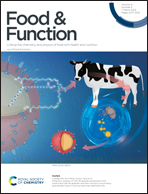Binding of ankaflavin with bovine serum albumin (BSA) in the presence of carrageenan and protective effects of Monascus yellow pigments against oxidative damage to BSA after forming a complex with carrageenan†
Abstract
Ankaflavin (AK) is a typical yellow pigment extracted from Monascus-fermented rice with several biological effects; however, its solubility is poor. Thus, research studies of the delivery systems of AK, especially those constructed from protein–polysaccharide complexes, have attracted considerable attention. However, the interactions that exist in the system have rarely been investigated. This work focused on the interactions between AK and bovine serum albumin (BSA) as well as the influence of carrageenan (Car) on the binding of AK to BSA. Results revealed that the quenching of BSA by AK involved the static quenching mechanism. The formed BSA–AK complexes were mainly maintained by hydrophobic forces and AK was located within the hydrophobic cavity of BSA. Compared to free AK or AK only complexed with BSA, a higher absorption intensity of AK was observed for the formed BSA–AK–Car complexes, indicating changes in the microenvironment of AK. This was confirmed by the increase in the α-helix content of BSA after the formation of BSA–AK–Car complexes. Hydrogen bond, van der Waals, and electrostatic interactions were verified to be the primary forces preserving the BSA–AK–Car complexes. Moreover, the antioxidant potential of Monascus-fermented products rich in AK (denoted as Mps), namely BSA–Mps and BSA–Mps–Car was evaluated. The antioxidant activity of Mps was negatively impacted by BSA, while the addition of Car could enhance the antioxidant capacity of BSA–Mps–Car complexes. Meanwhile, Mps showed a protective effect against free radical-induced oxidation damage to BSA, and Car could further improve this effect.



 Please wait while we load your content...
Please wait while we load your content...